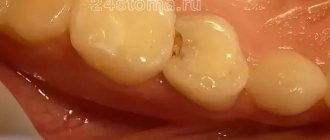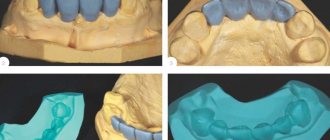If you need to correct the appearance of the dentition or strengthen it, dental restoration is performed with photopolymers . The material is wear-resistant and durable. But like all treatment methods, it has indications, contraindications and disadvantages.
Interesting to know! Photopolymer materials are resistant to various temperature conditions.
What is a photopolymer filling?
Photopolymer filling is a popular and convenient way to restore teeth, which uses photopolymer materials.
Composites harden in the oral cavity solely under the influence of a specific wave of light emanating from a lamp. Thanks to this property, the dentist can do his work slowly and creatively.
In addition, light-reflecting composites are available in different colors and degrees of transparency, and accordingly, with their help it is possible to hide darkened hard tissues and even metal, as well as restore enamel and dentin.
There is also technology that allows you to combine reflective and chemical materials. It is in this case that it is possible to make the most of all the advantages and neutralize the disadvantages of each method.
There are many reasons why photopolymer fillings are widely used in dentistry. The risk of cracks occurring during operation is minimized. All functions of the teeth are completely restored, while the patient’s sensations remain the same as with healthy teeth.
Photocurable composite materials in aesthetic restoration of permanent teeth
TRADITIONAL PHOTOPOLYMERS
The constituent components of composite materials are an organic monomer and inorganic fillers;
they also contain polymerization initiators, stabilizers, dyes and pigments that determine the quality of the filling. Restorative materials contain the product Bis-GMA (bis-phenol A (diphenylpropane) and glycidyl methacrylate-2). It has a number of positive properties. These are adhesion to tooth tissue, high mechanical strength, chemical resistance, and a low coefficient of thermal expansion. However, being a multi-component mixture, it is difficult to clean. The presence of volatile comonomers increases curing shrinkage. Color stability is insufficient due to the presence of impurities that cannot be removed. The latest generations of photopolymers contain, in addition to BisGMA, monomers UDMA and TEDMA. The organic matrix provides the composition with fluidity during the formation of the filling and stability, solidity, and tightness during operation. The filler forms the mechanical properties of the composition and affects the thermophysical, physicochemical and other properties of the material. Filling polymers with various types of quartz flour, aluminum and lithium silicates, hydroxyapatites, phosphates, borosilicates, etc. makes it possible to increase their rigidity, dimensional stability, in some cases strength and impact strength, improve heat resistance, reduce water absorption, shrinkage, exotherm, and provide the required color. One or more types of fillers can be introduced into the matrix. To achieve adhesion of the filler to the organic matrix, modification of the filler surface is used: finishing (treating the filler surface with special substances) or silanization (creating a polymer shell on filler particles). The interfacial layer significantly affects the properties of the composite. Its thickness is 10–30 µm.
Composites have 1.7 times less shrinkage than acrylic materials, their coefficient of thermal expansion is 4 times lower, their rigidity is 5 times higher, and their compressive strength is 3 times higher. They provide good mechanical retention.
Macrophilic composites include inorganic fillers ranging in size from 2 to 30 microns. Fillings made from macrophilic composites are difficult to polish and their surface changes color.
Microphiles contain small filler (up to 0.04 microns), are less mechanically stable, but are easily polished and retain their natural shine. In terms of optical properties, they are more consistent with enamel.
Hybrid composites are characterized by a variety of fillers, their high concentration and, as a rule, high-quality physical indicators. Materials, which mainly contain particles larger than 5 microns, are similar in basic parameters to macrophilic materials. If there are fillers with a diameter of 1–2 μm, then the composites belong to finely dispersed hybrid compositions, characterized by good optical and physical properties, high radiopacity, convenient consistency and slight abrasion of the filling and the antagonist tooth.
Microhybrids have good strength due to the high content of glass particles as fillers. Microhybrid can be highly polished, but over time the natural shine of the restoration decreases. They are universal and can be used for various types of defects.
The group of hybrid composites includes “Arabesk Top” (VOCO) - a light-curing composite based on BCS (B - bi, C - ceramic, S - system), a combination of two glass-ceramic structures with particles of different sizes. "Arabesque Top" has: natural aesthetics due to the chameleon effect, polishability to gloss, color stability, low shrinkage - 2.49% of the volume, tight edge fit in combination with the Solobond M adhesive system. The hardness of “Arabesque Top” is close to that of enamel, and the elastic modulus is close to dentin. Characterized by minimal abrasion. Available in 7 shades: A2, A3, A3.5, B2, B3, C2, OA2. A universal composite for restoring teeth with cavities of all Black classes, making veneers, color and shape correction, splinting.
An example of a microhybrid composite with an improved matrix is Amaris (VOCO), a highly filled (80% by weight) composite material based on a low-shrinkage methacrylate matrix (Bis-GMA, UDMA, TEGMA). "Amaris" polymerizes under the influence of visible blue light, it can be combined with any modern adhesive systems. Has opaque shades corresponding to the natural colors of dentin (01, 02, 03, 04, 05, Obleach). Enamel shades correspond to natural enamel: TL (translucent light); TN (neutral); TD (dark). Special shades have fluidity: HT (high translucency) and HO (high opacity). Indications for use: aesthetic restoration of carious cavities of classes III, IV and V (front teeth); aesthetic restoration of cavities of classes I, II and V (chewing teeth); reconstruction of traumatic dental injuries; aesthetic correction of color and shape disorders; repair of highly aesthetic veneers (including ceramic); splinting of anterior teeth.
We present a clinical case of veneer production. Opaque layers are applied deep into the cavity, enamel layers are applied in the direction of the vestibular surface (Fig. 1a).
Rice. 1a. A light opaque layer is modeled in the middle and gingival area of the incisor.
Opaque shades must correspond to enamel shades: dark opaque with TD, natural – with similar enamel, light – with TL (Fig. 1b).
Rice. 1b. The enamel layer is modeled in the area of the cutting edge.
The use of HT and HO shades creates high light transmission and high opacity to achieve a customized restoration look. The use of HT composite at the cutting edge will give the structure a unique appearance (Fig. 2).
Rice. 2. Modeling of the cutting edge.
The use of HO shade eliminates surface color irregularities.
"Amaris Gingiva" (Amaris Gingiva, VOCO) is a material containing 80% by weight fillers in a methacrylate matrix and cured by the action of blue light, intended for the treatment of defects in the area of the neck of the tooth and exposed, discolored necks of the teeth, especially in the visible frontal area (Fig. 3).
Rice. 3. Gum recession with exposure of the root of the central incisor.
The system consists of three different colored opaques, as well as a gum-colored composite as a base color. Opaques are designed to cover discolored tooth necks, as well as to match the restoration to a specific gum color (Fig. 4).
Rice. 4a. The root of the tooth is covered with pink photopolymer.
Rice. 4b. The gingival papilla is modeled.
NANOHYBRID MATERIALS
Nanohybrid composites contain polymer resins with high molecular weight and microfillers with an average particle size of 20-30 microns. Combining nanometers with glass-ceramic particles made it possible to increase the share of filler in the material to 87%, which reduced the content of organic resins in the matrix and, accordingly, reduced polymerization shrinkage to 1.57%. Filling the material with nanoparticles ensured high edge stability, easy polishability and good color fastness. Thanks to the chameleon property, the stage of selecting composite syringes is simplified. In some cases, one material may be used. In more complex clinical situations, 2-3 syringes with different color characteristics will be required. Nanocomposites are indicated for filling cavities of classes I-V according to Black, restoring teeth with traumatic injuries and defects in hard tissues of a non-carious nature (restoration of teeth with cavities
Class II of significant size; use in splinting, manufacturing inlays, onlays, adhesive prostheses, restoration of tooth stump).
An example is “Grandio” (Grandio, VOCO) - a nanohybrid composite containing nanometers (particles of zirconium silicate, ≤100 nm in size) with glass-ceramic particles of a hybrid composite, the share of filler in the material composition is increased to 87% by weight and 71.4% by volume . The material has high bending strength and high edge stability. High strength, low shrinkage coefficient (1.57%) provide good marginal adhesion and chewing resistance.
"Grandio" has 15 color shades: A1, A2, A3, A3.5, A4, B1, B2, B3, C2, C3, D3, I, OA2, OA3.5, BL. The material is intended for filling cavities of classes I-V according to Black, aesthetic filling of anterior teeth, correction of the shape and color of teeth, splinting, restoration of the tooth stump for a crown, making inlays and veneers. We present a clinical case of tooth restoration after a chipped crown (Fig. 5).
Rice. 5a. Chipped tooth up to 1/2 crown.
Rice. 5 B. Modeling mamelons with opaque composite.
Rice. 5th century Modeling the cutting edge with enamel layers: light.
Rice. 5g. Modeling the cutting edge with enamel layers: transparent.
MODIFIED COMPOSITE MATERIALS
Ormokers are composite materials based on organically modified ceramics, in which the organic matrix is modified: the composition includes organic polymers, glass ceramics, and polysiloxanes. Positive properties are strength and abrasion resistance; high aesthetic qualities, ability to be polished; color fastness.
The polymerization shrinkage of ormokers is 1.97% by volume. Indications for use: filling carious cavities of all classes according to Black; restoration of anterior teeth for defects of traumatic and non-carious origin; production of inlays and onlays.
Admira (VOCO) is an ormoker containing glass ceramic particles with an average diameter of ?0.7 µm and microfiller particles (silicon oxide) with a size of 0.04 µm. The filler is 78% by weight and 56% by volume. Admira includes color enamel shades: red-brown - A1, A2, A3, A3.5, A4; yellow - B2, B3; gray - C2, C3D, D3; incisal edge - I; opaques: universal opaque - UO, OA2, OA3.5, OB2; special whites - BL(OM), BXL(O) - 22 shades. Ormoker "Admira" has a pronounced chameleon effect and is intended for filling cavities of classes I-V according to Black, aesthetic filling of anterior teeth, correction of the shape and color of teeth, splinting, restoration of the tooth stump for a crown, making inlays and veneers.
FLUID COMPOSITE MATERIALS
They are a less viscous modification of traditional composites. The magnitude of their polymerization shrinkage increases slightly compared to traditional hybrids. They are thixotropic: they retain their shape at rest, do not leak out of the cavity, fill all irregularities, ensuring high-quality adaptation of the subsequent layer of composite and ideal marginal fit of the filling. Liquid CM creates an elastic “cushion” under the filling, compensating for the tension arising under the influence of occlusal load. The advantages of these materials: less viscous consistency; high elasticity; natural transparency; biocompatibility; radiopacity; color stability; compatibility with adhesive systems. Disadvantages: increased polymerization shrinkage; the need to apply a thin layer; low strength. They are used for filling cavities of class V according to Black, small cavities of classes I-III (minimal preparation technique); correction of shape and color in the enamel area; as a gasket in cavities of classes I and II; base layer for photopolymer; elastic gasket to relieve tension and strengthen the bonding layer; when repairing fillings and veneers, fixing ceramic crowns, veneers; splinting mobile teeth; invasive fissure sealing, filling of baby teeth.
This class of materials is represented by “Grandio Flow” (VOCO), containing nanometers (zirconium silicate particles ≤100 nm in size) with glass-ceramic particles of a hybrid composite. The material is characterized by thixotropy and has a chameleon effect. Available in five colors (A1, A2, A3, A3.5, B2) and is suitable for restoration of teeth with cavities of classes III-V, invasive fissure sealing, filling of baby teeth, and use in layer-by-layer restoration techniques (Fig. 6).
Rice. 6a. Using a flowable composite to hold one piece of adhesive tape in place.
Rice. 6b. Using a flowable composite to secure two pieces of adhesive tape.
Flowable ormoker "Admira Flow" (Admira Flow, VOCO), containing glass ceramic particles with an average diameter of ?0.7 microns, microfiller particles (silicon oxide) with a size of 0.04 microns (63% by volume), has optimal thixotropy, does not leak cavities, levels uneven surfaces of the cavity, has high elasticity, is characterized by natural transparency when recreating tooth shades, biocompatibility and low shrinkage (2.92%). The material is available in three shades: A2, A3, A3.5 (Fig. 7).
Rice. 7. The flowable composite camouflages the parapulpal pins.
CONCLUSION
Light-curing composite materials of various classes in a therapeutic dentistry clinic can significantly expand the indications for aesthetic restoration of teeth with defects of carious and non-carious origin. They are used to close diastemas and correct other orthodontic disorders. In the technique of adhesive splinting and prosthetics, photopolymers also provide high quality structures for defective dentition.
Kinds
Regardless of the type, a composite material is used to make a photopolymer filling. He can be:
- macro-filled;
- microfilled;
- minifilled;
- hybrid;
- compomer.
In addition, composites are divided into fluid and solid. They are placed in syringes and applied to the surface to be treated using tools specially designed for this purpose. Conventional ones are not suitable for this purpose, as the material will stick to them.
In case of restoration of the interdental contact point, as well as when filling the cervical area, they resort to the use of fluid polymer fillings.
It is they that fit as tightly as possible and are evenly distributed over the surface, due to which they create tight contact with hard tissues. They are easy to use. In this case, the possibility of applying more composite than necessary is completely excluded.
Let's find out why a tooth hurts after a temporary filling
In the process of restoration of anterior teeth, it is customary to use solid photopolymers. They are plastic, thanks to which they can give the tooth any shape and will fully correspond to the anatomical structure.
When restoring a large cavity, the material is applied in layers, since the rays of the lamp cannot penetrate into the deep layers. For more reliable fixation, the enamel is highlighted first and only then the remaining areas.
Indications and contraindications
There are a number of indications for which the use of photopolymer materials is used. The main ones:
- tooth fracture;
- change in color of enamel that cannot be bleached:
- significant defects of tooth enamel;
- the presence of large fillings in the cervical area;
- noticeable interdental gaps;
- the need for minor correction of the position of the teeth;
- damage to the crown by a maximum of forty percent.
Even if there are indications for installing a filling, a specialist may refuse to carry out the necessary treatment. Among the main contraindications for installation are the following:
- bruxism;
- severe destruction of the front teeth;
- active development of caries;
- teeth subjected to intensive fluoride treatment;
- lack of proper oral hygiene.
Some of the contraindications are classified as conditional. Over time, they can be eliminated, and, accordingly, there will no longer be barriers to installing fillings made of photopolymer materials.
When are photopolymers used?
When are photopolymers used?
Using light-curing composites, teeth can be restored in the following way:
- adjust shape, length, shade;
- strengthen loose teeth;
- build a tooth onto the root;
- using an adhesive bridge to recreate a lost tooth.
Indications for photopolymer filling are mechanical trauma to the tooth, pulpitis, caries, periodontitis (inflammation of the peri-root tissues). Light composites prevent further tooth destruction, but do not eliminate inflammation in the roots or perforation. Also, light composites will not help with a critical degree of loosening of the dentition.
Installation
The process of installing a photopolymer filling is carried out in several stages. Most often, treatment is carried out according to this plan:
- Administration anesthetic drug.
- Preparation of the area affected by caries.
- Treatment with medications.
- Isolation of saliva and mandatory drying.
- Application of acid to improve adhesion.
- Thorough rinsing and drying.
- Application of adhesive material.
- Layer-by-layer application of the composite.
- Polishing and grinding.
If the depth of the lesion is too great, then additionally resort to the use of a therapeutic and insulating pad. If dentin layers are damaged, they must be isolated. In those cases when the cavity is excessively large, first a medicinal material is placed into it and only then an insulating material.
The process of etching the enamel can be carried out both before and after insulation. The gel, which contains orthophosphoric acid, is applied exclusively to the dried surface. Only in this case will it be possible to achieve the desired effect.
After applying the adhesive system, it is sprayed using an air stream. Then the material is illuminated with a lamp for literally half a minute. The filling is formed by layer-by-layer application of reflective material.
At the final stage of installation, the filling is ground, removing all irregularities and polished. The tooth acquires natural smoothness and shine. It is almost impossible to distinguish it from natural one.
Care
The rules for caring for photopolymer fillings are practically no different from ordinary oral hygiene.
Patients simply need to brush their teeth regularly with a soft toothbrush and rinse their mouth with warm water or a special solution after each meal.
It is also important to regularly, at least once every six months, have a routine examination with a dentist. Only if problems are detected in a timely manner can they be easily eliminated and the development of more serious diseases prevented, and accordingly preserve the integrity of the tooth that has been restored.
Life time
The service life of photopolymer fillings largely depends on the quality of the material and the competence of the specialist. In addition, the patient himself is able to both shorten and significantly extend the service life of the filling.
The materials used in the filling process can be either highly durable or less reliable. Provided that a high-quality composite is used, it can last up to seven years.
There are cases when the filling falls out almost immediately after its installation. There may be several reasons for this. It is possible that when filling, the doctor made a mistake, as a result of which the material was not securely fixed. The most common cause is adhesion failure due to saliva or liquid.
Find out why a tooth hurts after filling
In such cases a guarantee is issued. Within a year after the filling is installed, the patient can apply for a repeat procedure. There is no charge for the service.
It is also possible that the patient simply did not follow all medical recommendations. In this case, you also need to seek help from a specialist. It is advisable to give preference to those clinics that have only positive recommendations. In this case, the risk of the filling falling out will be minimal.
What is a light or reflective seal?
So, a light filling (photopolymer, light-polymer, reflective, polymer, light-hardening, etc.) is considered one of the highest quality and most durable materials. However, its main advantage is its high aesthetics. It is almost invisible on the teeth and can be used to correct the frontal area.
Many people ask the question: “What is the difference between a light filling and a regular one?” In fact, the main difference between these two materials is the speed of hardening. For example, if a photopolymer filling hardens under the influence of ultraviolet radiation within a few seconds, then in order for the chemical material to acquire the necessary hardness, you need to wait 2 hours until its components react. That is why a light-curing filling or light-curing filling is optimal for high-quality and aesthetic dental restoration.
The most important advantage of a light filling is the variety of its color tones. This allows you to select the exact color that fully matches the natural shade of the patient’s tooth enamel in each individual case.
[]
Do's and don'ts after installation
When installing light fillings, the doctor gives a number of recommendations, following which it is possible to preserve their integrity for many years. The most important of them are the following:
- Eliminate viscous foods from the diet that can lead to loss of the composite.
- Avoid excessively hard foods such as nuts and crackers, especially in cases where the front teeth have been restored.
- Get rid of the habit of biting your nails and biting threads.
- Brush regularly, at least twice a day .
- professionally once every six months . In this case, be sure to inform the specialist that photopolymer fillings have been installed and indicate their exact location.
- For several days after the filling is installed, do not eat foods that contain dyes. Otherwise, the material will darken and the tooth will lose its natural appearance.
The main advantage of fillings made from photopolymer materials is that you can eat food immediately after the procedure. If chemicals are used, it is necessary to wait at least two hours for the cement to completely harden.
Advantages and disadvantages
The demand for photopolymer fillings is due to a number of their advantages. The main ones are the following:
- it is possible to accurately restore the relief and shape of teeth even in cases where they are too damaged;
- the filling is combined with hard tissue into a single whole thanks to a special adhesive system;
- after hardening, the material becomes durable, securely bonded to the enamel, and resistant to cracking;
- it is possible to achieve the desired cosmetic effect by selecting the desired color shade of the material;
- installation is carried out by applying the composite layer by layer, thereby creating an imitation of natural dental tissues;
- preparation of cavities and defects is reduced to a minimum;
- In case of delamination or chipping, adhesive correction is possible.
Among the disadvantages of such fillings, one can highlight only shrinkage of the composite when exposed to light and insufficient polymerization. The polymer does not harden completely, and therefore the original shade may change over time.
Photopolymer fillings have many advantages, which is why they are most often used in dentistry. This is a reliable type of dental restoration, with the help of which it is possible to give even severely damaged hard tissues a natural appearance.
Another peculiarity of the use of light composites is that the material hardens only under the influence of a special lamp. Accordingly, the specialist has the opportunity to clearly recreate the natural shape of the tooth, which is very difficult when using other materials.
How are photopolymer fillings installed?
Interesting to know!
Light-curing fillings harden only under the influence of ultraviolet light, so the doctor can model any tooth shape without fear that the material will harden prematurely. The procedure is low-traumatic, but if the patient is particularly sensitive, a local anesthetic is used. Filling stages:
- Cleaning the dental cavity, removing dead tissue. If the pulp is affected by the destructive process, it is also removed.
- Elimination of organic substances and micro-sawdust that entered the cavity during cleaning.
- Root canal cleaning.
- Installation of a “Cofferdam” (rubberdam) - a latex plate to isolate the tooth from saliva, otherwise the photopolymer filling will quickly fall out.
- Filling an empty cavity with dental glue, which connects the tooth tissue and the filling material.
- Application of photopolymer in several layers, each of which is dried and hardened under the influence of ultraviolet radiation.
- Modeling and correction of curves and shapes.
- Making a crown, polishing it, grinding it.
- Checking the seal using special paper.
Important! Photopolymer fillings can be installed even for children if they do not have progressive caries.











